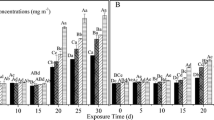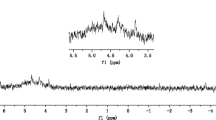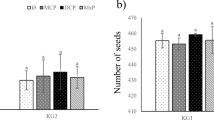Abstract
Purpose
The aim of this study was to evaluate the role of phosphine in the mobilization of phosphorus in the rhizosphere soil of rice seedlings and to determine the relative efficiency of phosphine in plant P acquisition.
Materials and methods
An indoor simulation experiment was conducted and the matrix-bound phosphine (MBP), phosphorus fractions, and phosphatase activity in the rhizosphere soil samples from rice cultivation, biomass, the plant P, and the root system activity were measured under different phosphine concentrations (0, 1.4, 4.2, and 7.0 mg m−3) for a period of 30 days.
Results and discussion
The results indicated that phosphine treatments enhanced MBP, inorganic P (resin–Pi, NaHCO3–Pi, and NaOH–Pi), and phosphatase activity, as well as the root system activity, and the content of P in the rice seedlings was stimulated with increasing phosphine concentrations. However, organic P (NaHCO3–Po and NaOH–Po) accumulation occurred in the rhizosphere of the rice seedlings. In addition, the content of organic P in the soil samples decreased with increased phosphine concentration.
Conclusions
Therefore, relatively high concentrations of phosphine in paddy field could have a positive impact on the effectiveness of phosphorus in rice plants via influencing the rhizosphere properties.




Similar content being viewed by others
References
Aspila KI, Agemian H, Chau ASY (1976) A semi-automated method for the determination of inorganic, organic and total phosphate in sediments. Analyst 101:187–193
Bertrand I, Hinsinger P, Jaillard B, Arvieu JC (1999) Dynamics of phosphorus in the rhizosphere of maize and rape grown on synthetic, phosphated calcite and goethite. Plant Soil 211:111–119
Bhadraray S, Purakayastha T, Chhonkar P, Verma V (2002) Phosphorus mobilization in hybrid rice rhizosphere compared to high yielding varieties under integrated nutrient management. Biol Fertil Soils 35:73–78
Bowen GD, Rovira AD (1966) Microbial factor in short-term phosphate uptake studies with plant roots. Nature 211:665–666
Bowen GD, Rovira AD (1999) The rhizosphere and its management to improve plant growth. Adv Agron 66:91–102
Cao HF, Liu JA, Zhuang YH, Glindemann D (2000) Emission sources of atmospheric phosphine and simulation of phosphine formation. Sci China B 43:162–168
Chen CR, Condron LM, Davis MR, Sherlock RR (2002) Phosphorus dynamics in the rhizosphere of perennial ryegrass (Lolium perenne L) and radiata pine (Pinus radiata D Don). Soil Biol Bioche 34:487–499
Czarnes S, Hiller S, Dexter AR, Hallett PD, Bartoli F (1999) Root: soil adhesion in the maize rhizosphere: the rheological approach. Plant Soil 211:69–86
Dévai I, Felfoldy L, Wittner I, Plosz S (1988) Detection of phosphine: new aspects of the phosphorus cycle in the hydrosphere. Nature 333:343–345
Föhse D, Claassen N, Jungk A (1988) Phosphorus efficiency of plants I external and internal P requirement and P uptake efficiency of different plant species. Plant Soil 110:101–109
Föhse D, Claassen N, Jungk A (1991) Phosphorus efficiency of plants. II. Significance of root radius, root hairs and cation–anion balance for phosphorus influx in seven plant species. Plant Soil 132:261–272
Geng J, Niu X, Wang X, Edwards M, Glindemann D (2010) The presence of trace phosphine in Lake Taihu water. Int J Environ Anal Chem 90:737–746
Geng JJ, Niu XJ, Jin XC, Wang XR, Gu XH, Edwards M, Glindemann D (2005) Simultaneous monitoring of phosphine and of phosphorus species in Taihu Lake sediments and phosphine emission from lake sediments. Biogeochemistry 76:283–298
George TS, Gregory PJ, Robinson JS, Buresh RJ (2002) Changes in phosphorus concentrations and pH in the rhizosphere of some agroforestry and crop species. Plant Soil 246:65–73
Glindemann D, Edwards M, Liu J, Kuschk P (2005) Phosphine in soils, sludges, biogases and atmospheric implications—a review. Ecol Eng 24:457–463
Guo W, Zhao J, Li X, Qin L, Yan X, Liao H (2011) A soybean beta-expansin gene GmEXPB2 intrinsically involved in root system architecture responses to abiotic stresses. Plant J 66:541–552
Han C, Geng JJ, Hong YN, Zhang R, Gu XY, Wang XR (2011a) Free atmospheric phosphine concentrations and fluxes in different wetland ecosystems. China Environ Pollut 159:630–635
Han C, Geng J, Zhang R, Wang X, Gao S (2011b) Matrix-bound phosphine and phosphorus fractions in paddy soils. J Environ Monitor 13:844
Han SH, Zhuang YH, Liu JA, Glindemann D (2000) Phosphorus cycling through phosphine in paddy fields. Sci Total Environ 258:195–203
Han SH, Zhuang YH, Zhang HX, Wang ZJ, Yang JZ (2002) Phosphine and methane generation by the addition of organic compounds containing carbon-phosphorus bonds into incubated soil. Chemosphere 49:651–657
Hayes JE, Richardson AE, Simpson RJ (2000) Components of organic phosphorus in soil extracts that are hydrolysed by phytase and acid phosphatase. Biol Fertil Soils 32:279–286
Hedley MJ, Nye PH, White RE (1983) Plant-induced changes in the rhizosphere of rape (Brassica napusvar Emerald) seedlings IV the effect of rhizosphere phosphorus status on the pH, phosphatase activity and depletion of soil phosphorus fractions in the rhizosphere and on the cation-anion balance in the plants. New Phytol 95:69–82
Hedley MJ, Stewart JWB, Chauhan BS (1982) Changes in inorganic and organic soil phosphorus fractions induced by cultivation practices and by laboratory incubations. Soil Sci Soc Am J 46:970–976
Hong YN, Geng JJ, Qiao S, Zhang YZ, Ding LL, Wang XR, Ren HQ (2010) Phosphorus fractions and matrix-bound phosphine in coastal surface sediments of the southwest Yellow Sea. J Hazard Mater 181:556–564
Huang B, Duncan RR, Carrow RN (1997) Drought-resistance mechanisms of seven warm-season turf grasses under surface soil drying II root aspects. Crop Sci 37:1863–1869
Islam E, Yang XE, Li TQ, Liu D, Jin XF, Meng FH (2007) Effect of Pb toxicity on root morphology, physiology and ultrastructure in the two ecotypes of Elsholtzia argyi. J Hazard Mater 147:806–816
Joslin JD, Henderson GS (1984) The determination of percentages of living tissue in woody fine root samples using triphenyltetrazolium chloride. Forestry Science 30:965–970
Johnson AH, Frizano J, Vann DR (2003) Biogeochemical implications of labile phosphorus in forest soils determined by the Hedley fractionation procedure. Oecologia 135:487–499
Jones DL, Hodge A, Kuzyakov Y (2004) Plant and mycorrhizal regulation of rhizodeposition. New Phytol 163:459–480
Jungk AO (1987) Soil-root interactions in the rhizosphere affecting plant availability of phosphorus. J Plant Nutr 10:1197–1204
Kuchenbuch R, Jungk AO (1982) A method for determining concentration profiles at the soil-root interface by thin slicing rhizosphere soil. Plant Soil 68:391–394
Lavakush YJ, Verma JP, Jaiswal DK, Kumar A (2014) Evaluation of PGPR and different concentration of phosphorus level on plant growth, yield and nutrient content of rice (Oryza sativa). Ecol Eng 62:123–128
Li YF, Luo AC, Wei XH, Yao XG (2008) Changes in phosphorus fractions, ph, and phosphatase activity in rhizosphere of two rice genotypes. Pedosphere 18:785–794
Lu DZ (1988) Relations between physiological heterosis of root and shoot systems of hybrid rice Proceedings of the International Symposium on Hybrid Rice. Changsha, Hunan
Marschner H (1995) Mineral nutrition of higher plants. Academic, London, p 912
Maseko ST, Dakora FD (2013) Plant enzymes, root exudates, cluster roots and mycorrhizal symbiosis are the drivers of P nutrition in native legumes growing in P deficient soil of the Cape fynbos in South Africa. J Agr Sci Tech-Iran 3:331–340
Mudge SR, Smith FW, Richardson AE (2003) Root specific and phytase-regulated expression of phytase under the control of a phosphate transporter promoter enables Arabidopsis to grow on phytate as a sole P source. Plant Sci 165:871–878
Newman EJ (1987) Root microorganisms: their significance in the ecosystem. Biol Rev 53:511–554
Niu XJ, Geng JJ, Wang XR, Wang CH, Gu XH, Edwards M, Glindemann D (2004) Temporal and spatial distributions of phosphine in Taihu Lake, China. Sci Total Environ 323:169–178
Niu XJ, Mi LN, Li YD, Wei AS, Yang ZQ, Wu JD, Zhang D, Song XF (2013a) Physiological and biochemical responses of rice seeds to phosphine exposure during germination. Chemosphere 93:2239–2244
Niu XJ, Wei AS, Li YD, Mi LN, Yang ZQ, Song XF (2013b) Phosphine in paddy fields and the effects of environmental factors. Chemosphere 93:1942–1947
Niu XJ, Li L, Wu H, Song XF, Lai SC, Yang ZQ, Zou DH (2015a) Effects of phosphine on enzyme activities and available phosphorus in rhizospheric and non-rhizospheric soils through rice seedlings. Plant and Soil 387:143–151
Niu XJ, Wang JX, Wu H, Wu H, Wang CH, Yang ZQ, Song XF (2015b) Matrix-bound phosphine in the paddy soils of South China and its relationship to environmental factors and bacterial composition. Journal Soils Sediments. doi:10.1007/s11368-015-1258-4
Obalum SE, Watanabe Y, Igwe CA et al (2013) Improving on the prediction of cation exchange capacity for highly weathered and structurally contrasting tropical soils from their fine-earth fractions. Commun Soil Sci Plan 44(12):1831–1848
Roels J, Huyghe G, Verstraete W (2005) Microbially mediated phosphine emission. Sci Total Environ 338:253–265
Roels J, Willy V (2001) Biological formation of volatile phosphorus compounds. Bioresour Technol 79:243–250
Rutishauser BV, Bachofen R (1999) Phosphine formation from sewage sludge cultures. Anaerobe 5:525–531
Ryan PR, Delhaize E, Jones DL (2001) Function and mechanism of organic anion exudation from plant roots. Annu Rev Plant Physiol Plant Mol Biol 52:527–560
Sharpley AN (1985) Phosphorus cycling in unfertilized and fertilized agricultural soils. Soil Sci Soc Am J 49:905–911
Silberbush M, Shomer-Ilan A, Waisel Y (1981) Root surface phosphatase activity in ecotypes of Aegilops peregrina. Physiol Plant 53:501–504
Tarafdar JC, Chhonkar PK (1978) Status of phosphatases in the root-soil interface of leguminous and non-leguminous crops. Z P flanzenernähr Bodenkd 141:347–351
Usuda H, Shimogawara K (1991) Phosphate deficiency in maize I Leaf phosphate status, growth, photosynthesis and carbon partitioning. Plant Cell Physiol 32:497–504
Wang X, Yan X, Liao H (2010) Genetic improvement for phosphorus efficiency in soybean: a radical approach. Ann Bot 106:215–222
Ward JT, Lahner B, Yakubova E, Salt DE, Raghothama KG (2008) The effect of iron on the primary root elongation of Arabidopsis during phosphate deficiency. Plant Physiol 147:1181–1191
Yang X, Post WM (2011) Phosphorus transformations as a function of pedogenesis: a synthesis of soil phosphorus data using Hedley fractionation method. Biogeosciences 8:2907–2916
Yang JC, Wang ZG, Zhou J, Jiang HM, Zhang JF, Pan P, Han Z, Lu C, Li LL, Ge CL (2012) Inorganic phosphorus fractionation and its translocation dynamics in a low-P soil. J Environ Radioactiv 112:64–69
Yin XX, Hua L, Zhang ZX, Hua LP, Gao J (2005) Study on the effectiveness of phosphorus and mechanism of its circle in soil. Journal of Capital Normal University 26:95–101 (in Chinese)
Zeng LS, Liao M, Chen CL, Huang CY (2006) Effects of lead contamination on soil enzymatic activities, microbial biomass, and rice physiological indices in soil-lead-rice (Oryza sativa L) system. Ecotox Environ Safe 67:67–74
Zhang FS, Ma J, Cao YP (1997) Phosphorus deficiency enhances root exudation of low-molecular weight organic acids and utilization of sparingly soluble inorganic phosphates by radish (Raghanus satiuvsL) and rape (Brassca napusL) plants. Plant Soil 196:261–264
Zhang J, Geng JJ, Zhang R, Ren HQ, Wang XR (2010) Matrix-bound phosphine in paddy fields under a simulated increase in global atmospheric CO2. Environ Chem 7:287–291
Zhu R, Kong D, Sun L, Geng J, Wang X, Glindemann D (2006) Tropospheric phosphine and its sources in coastal Antarctica. Environ Sci Technol 40:7656–7661
Zhu R, Ma D, Ding W, Bai B, Liu Y, Sun J (2011) Occurrence of matrix-bound phosphine in polar ornithogenic tundra ecosystems: effects of alkaline phosphatase activity and environmental variables. Sci Total Environ 409:3789–3800
Zhu RB, Wei D, Hou LJ, Wang Q (2014) Matrix-bound phosphine and phosphorus fractions in surface sediments of Arctic Kongsfjorden, Svalbard: effects of glacial activity and environmental variables. Chemosphere 103:240–249
Acknowledgments
This work was supported by the National Natural Science Foundation of China, Grant (Nos. 41071305, 41105083 and 51008128), Guangdong Provincial Social Development Research Project (No. 2011B031000012), and the Fundamental Research Funds for the Central Universities (2012ZM0040) and State Key Lab of Subtropical Building Science, South China University of Technology (2014KB13).
Author information
Authors and Affiliations
Corresponding author
Additional information
Responsible editor: Chengrong Chen
Rights and permissions
About this article
Cite this article
Wang, J., Li, L., Niu, X. et al. Phosphine-induced phosphorus mobilization in the rhizosphere of rice seedlings. J Soils Sediments 16, 1735–1744 (2016). https://doi.org/10.1007/s11368-016-1366-9
Received:
Accepted:
Published:
Issue Date:
DOI: https://doi.org/10.1007/s11368-016-1366-9




